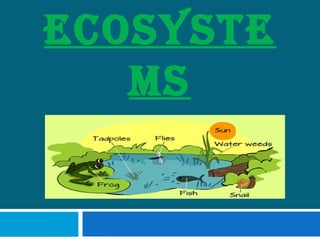
Unit 2. Ecosystems
- 1. ECOSYSTE MS
- 2. What is an ecosystem? Group of living and non-living things that live in the same area. They all interact.
- 3. Living things in an ecosystem: They are organised in: Species: group of organisms that can reproduce with each other and produce fertile offspring. Population: all the individuals that belong to the same species. Community: group of different populations that live together.
- 4. How do they interact? Depending on how living things get their food they can be classified in: Producers: they are the plants. They use soil and energy to perform the photosynthesis and produce food. Other living things use plants as food.
- 5. How do they interact? Decomposers: bacteria and fungi. They feed off the remains of dead animals and plants. Then, they return this nutrients to the soil for the plants.
- 6. How do they interact? Composers: animals and organisms that feed on other living things. Primary consumers: they eat producers, so they are herbivores (rabbits eat grass). Secondary consumers: they eat other consumers, so they are carnivores (eagles eat rabbits). Tertiary consumers: eat both producers and consumers, so they are omnivores (birds eat fruits and worms).
- 7. How do they interact?
- 8. Food chains and food webs Food chain: living things eat each other passing the energy from one to another.
- 9. Food chains and food webs Food webs: most living things are part of several food chains. When we connect them, we have a food web.
- 10. Food chains and food webs Balance of living things: if one population changes, it can affect other populations. As a result, it modifies the ecological balance. When a big change affects the balance of living things, it can lead to the extinction of species.
- 11. Terrestrial ecosystems Cold deserts: Antarctica and Greenland. They have: Freezing temperatures Little precipitation Land is covered with snow and ice Very little vegetation Animals have thick layer of fat
- 13. Terrestrial ecosystems Taiga: in Russian means dense evergreen forest. Covers the very North of Europe, Asia and North America. It has: Very cold temperatures (snow in Winter) Long and reainy days in Summer Many evergreen trees
- 15. Terrestrial ecosystems Temperate forests: are located in canada, eastern United States, Europe and China. They have: Cold temperatures in Winter and mild in Summer Moderate rain Most trees are deciduous Wide variety of animals that migrate during cold winters
- 17. Terrestrial ecosystems Warm deserts: Sahara and Atacama deserts. They have: High temperatures during day and cool at night Scarce precipitation Very little vegetation Animals can survive with little amounts of water.
- 20. Terrestrial ecosystems Savannahs: cover half the surface of Africa. You can also find them in Australia, South America and India. They have: High temperatures all year There is a dry season (almost no rain) and a wet season (lots of rain) Land is covered mostly in grass, few trees and shrubs Wide variety of animals
- 22. Terrestrial ecosystems Rainforests and jungles: Amazon and Congo are the largest in the world. They have: High temperatures Rains all year long Abundant vegetation
- 24. Aquatic ecosystems There are two type of aquatic ecosystems: Marine: the oceans and the seas Freshwater: lakes, ponds, rivers and streams
- 25. Aquatic ecosystems Marine ecosystems: in it we can find producers, consumers and decomposers. Producers: phytoplankton (algae). They perform photosynthesis. Consumers: fish, marine mammals, starfish, coral and zooplankton. Decomposers: fungi, bacteria and other microorganisms.
- 26. Aquatic ecosystems φύτον (phy to n, "planta") y πλαγκτος ("plánktos", "vagabundo" o "el que va dando tumbos") ‘Zoo’ (animal) y πλαγκτός [p la g któ s ], ‘errantes’